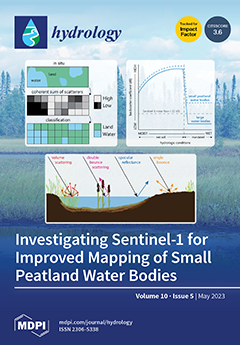Spatiotemporal variations in reference evapotranspiration (
ETo) are sensitive to the meteorological data used in its estimation. The sensitivity of the ASCE standardized
ETo equation to meteorological variables from GOES-PRWEB dataset was evaluated for the island of Puerto Rico. Island
[...] Read more.
Spatiotemporal variations in reference evapotranspiration (
ETo) are sensitive to the meteorological data used in its estimation. The sensitivity of the ASCE standardized
ETo equation to meteorological variables from GOES-PRWEB dataset was evaluated for the island of Puerto Rico. Island wide,
ETo is most sensitive to daily mean relative humidity (
RHmean), followed by solar radiation, daily maximum (
Tmax) and minimum (
Tmin) air temperatures, and wind speed with average absolute relative sensitivity coefficients (SCs) of 0.98, 0.57, 0.50, 0.27, and 0.12, respectively. The derived SCs guided the prioritization of bias correction of meteorological data for
ETo estimation from two downscaled climate models (CNRM and CESM). The SCs were applied to evaluate how meteorological variables contribute to model errors and projected future changes in
ETo from 1985–2005 to 2040–2060 at irrigated farms in the south. Both models project a 5.6% average increase in annual
ETo due to projected increases in
Tmax and
Tmin and a decrease in
RHmean. Despite
ETo being most sensitive to relative changes in
RHmean, the contributions from
RHmean,
Tmax, and
Tmin to future changes in
ETo are similar. CESM projects increases in
ETo in March, November, and December, increasing the potential for crop water stress. Study limitations are discussed.
Full article





